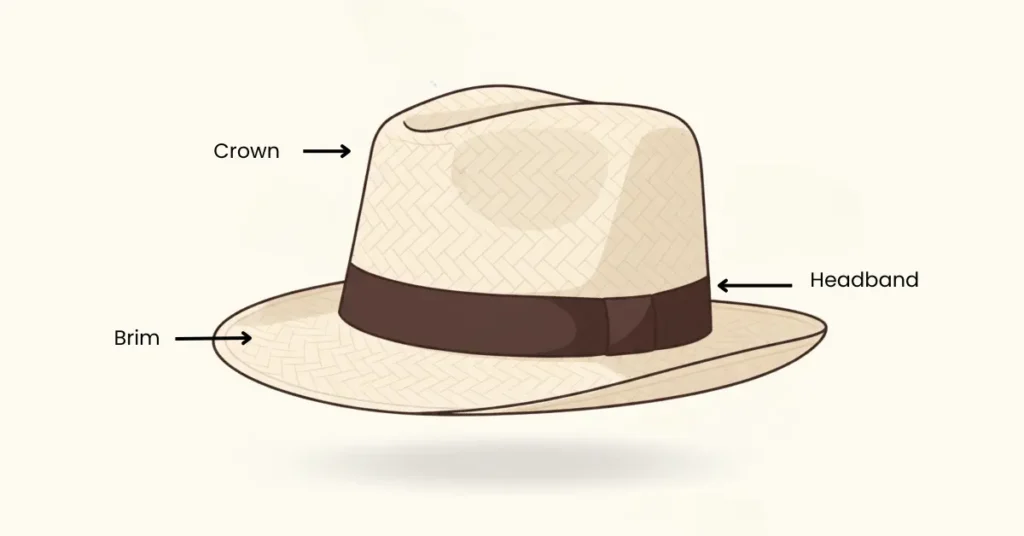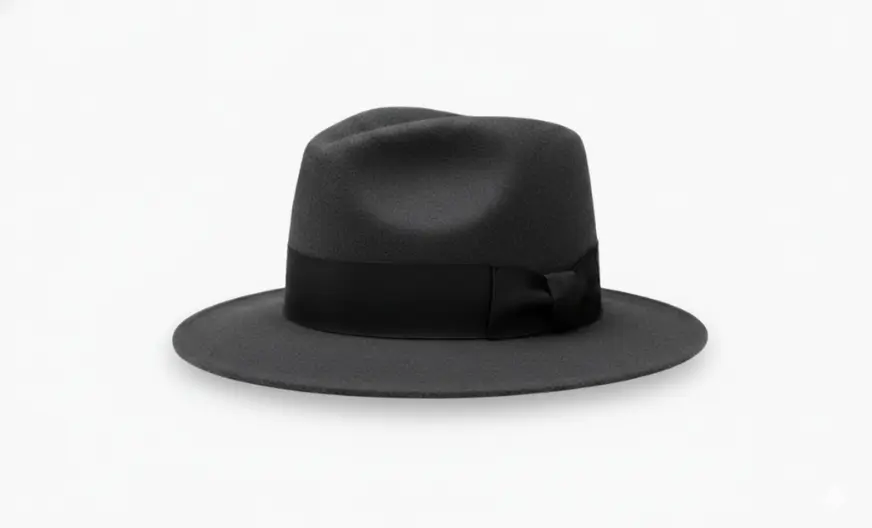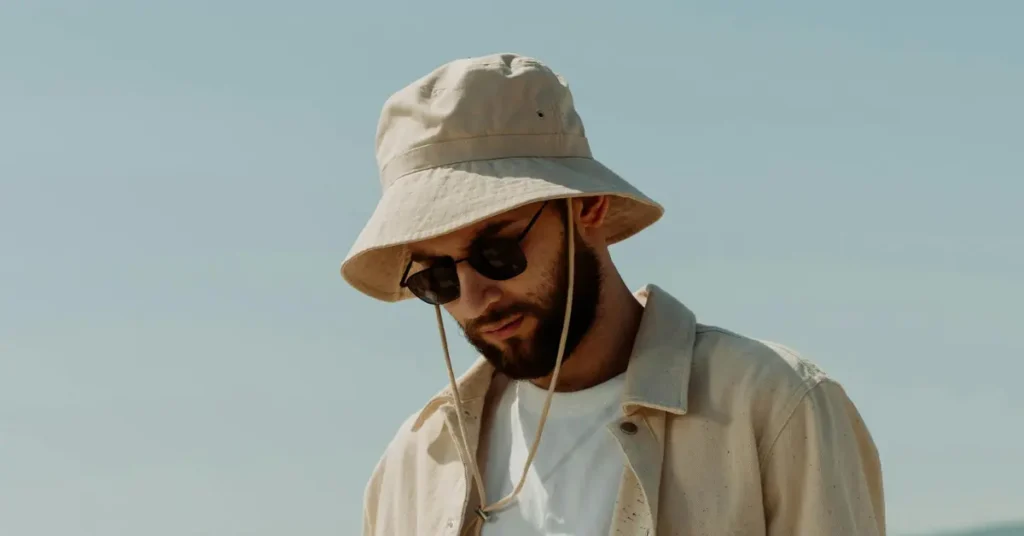A hat is made up of several parts, each with its own name and purpose.
The main ones are the crown, which sits on top of your head; the brim, which extends outward to shield your face from the sun; and the hat band, a strip that wraps around the base of the crown.
Together, these hat pieces define the hat’s shape, balance, and overall style.
Let’s take a closer look at each part to understand what makes a hat truly a hat.
The Parts of a Hat
When you look at a hat, it might seem simple, but every hat is made up of specific parts that give it structure and character. Once you learn these hat parts’ names, you’ll never look at hats the same way again.
You can also take a look at our hat parts diagram below to see where everything is placed. It shows each piece clearly, including the crown, brim, hat band, and rim.
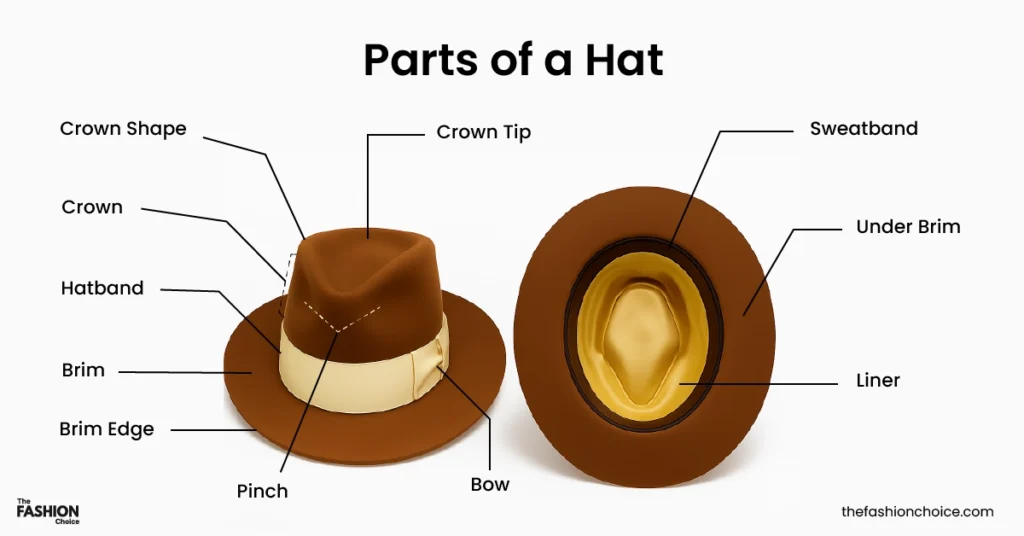
The Crown
The crown is the top part of the hat that sits on your head. It defines the hat’s structure and helps it fit properly. A tall crown gives the hat a sharp, classic shape, while a short or soft crown creates a more relaxed and casual feel.
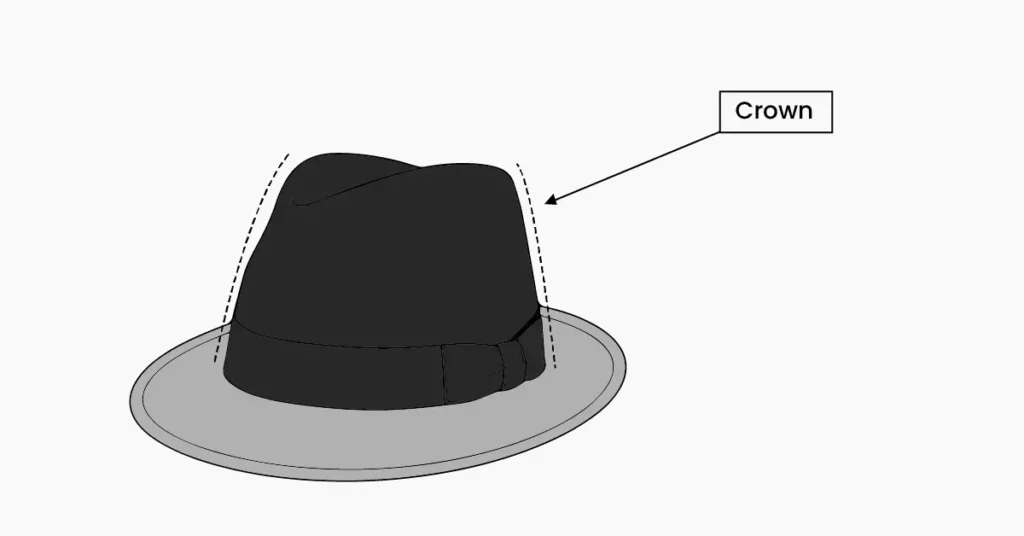
At the very top of the crown is the crown tip. Some crowns are flat, rounded, or slightly indented. The shape of this part changes how the hat looks from every angle.
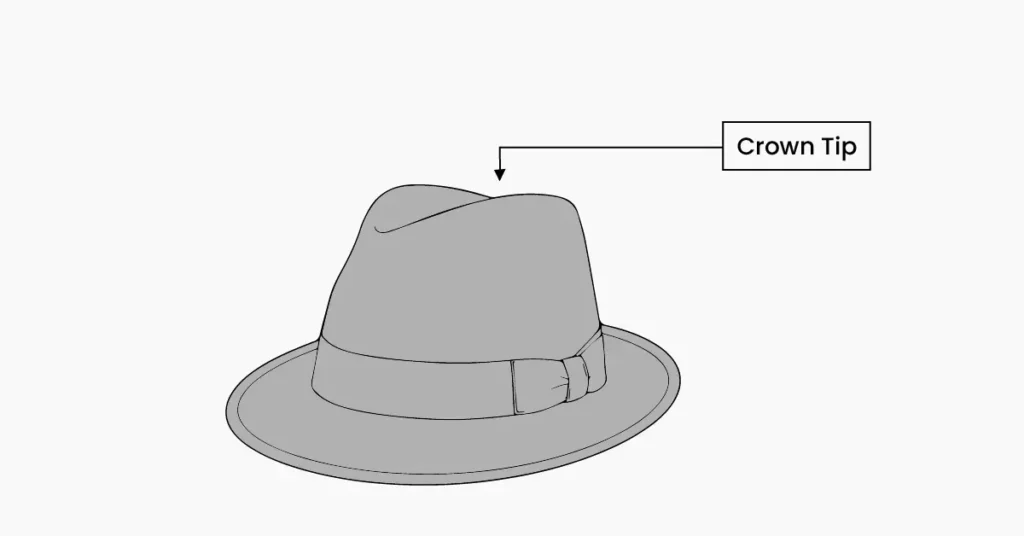
Many hats also feature a pinch at the front or sides of the crown. This design isn’t just decorative—it gives your fingers a natural place to grab the hat when you put it on or take it off. It also adds character and shape. Fedora and Panama hats are good examples.
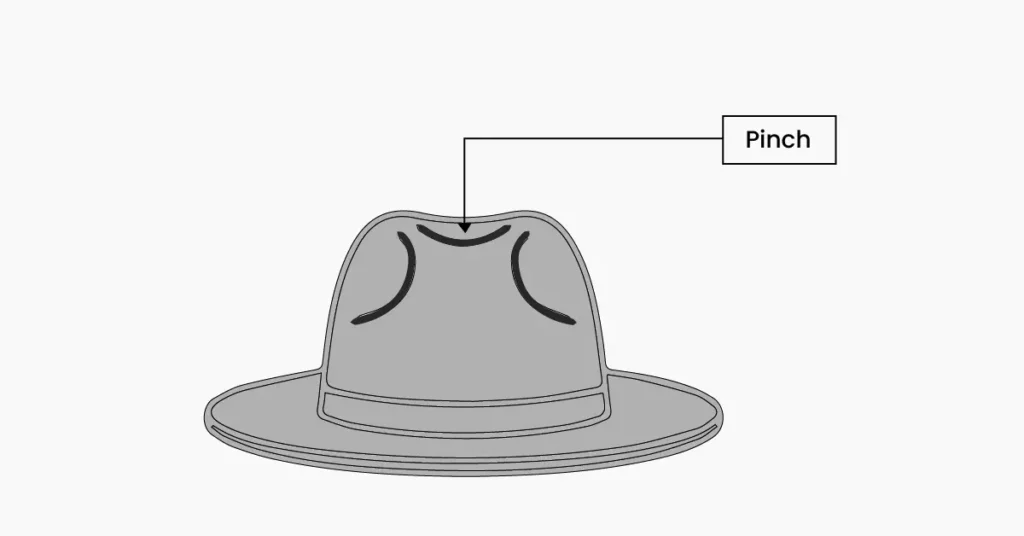
Some crowns also include dents or creases. A dent is an inward dip on the top or sides of the crown, while a crease is a line running along it. These details shape the crown, give it personality, and can make the hat easier to handle. Fedora and Panama hats are good examples of crowns with these features.
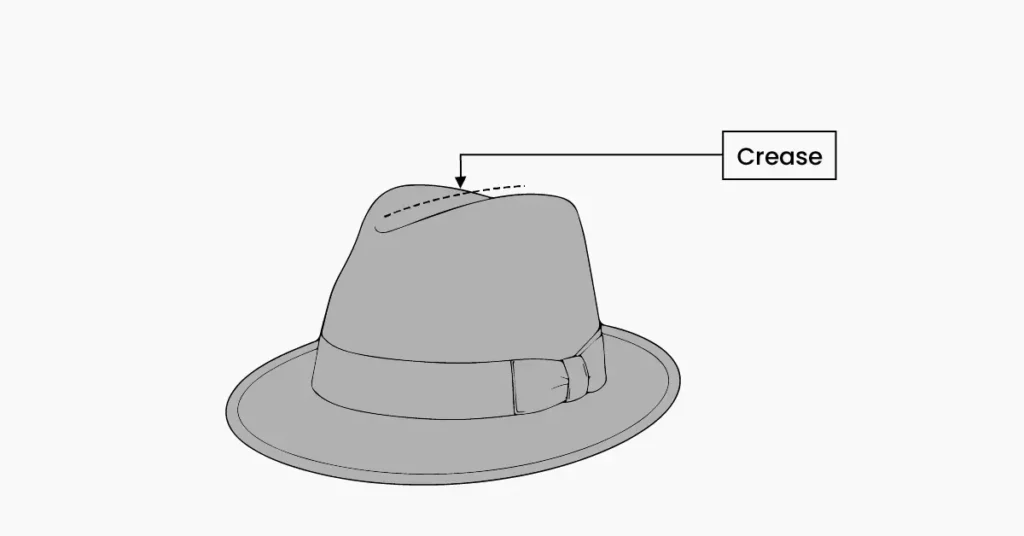
We always tell people that the hat crown isn’t just about looks. Get it wrong, and even the nicest hat won’t feel right on your head.
The Brim
The brim is the part that sticks out from the crown. Its main job is to protect your face and neck from the sun, but it also gives the hat its attitude and overall style. A wide brim feels bold and classic, like in a cowboy or sun hat. A narrow or short brim looks neater and more refined, like in a trilby or fedora.
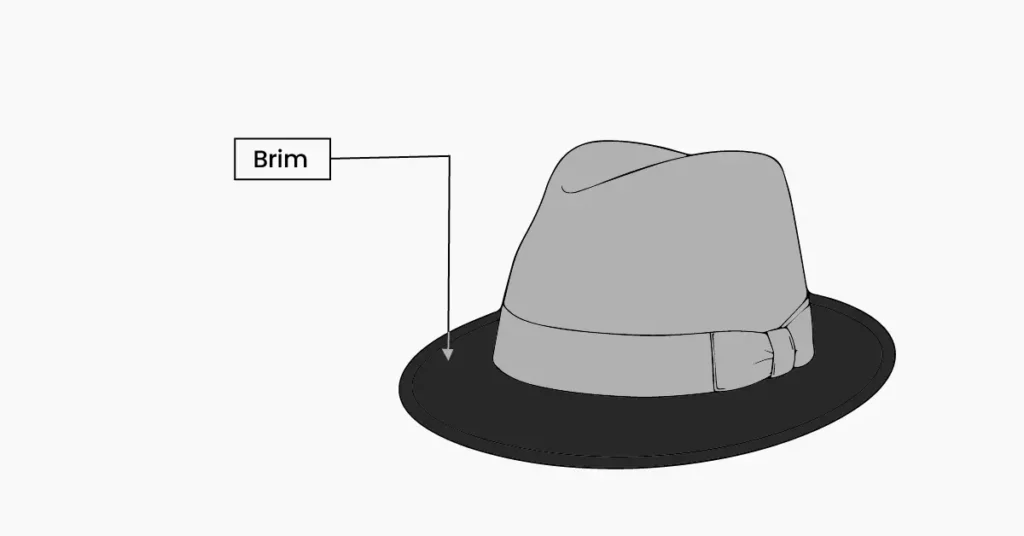
The angle of the brim makes a big difference. Tilt it down, and the hat feels softer or mysterious. Turn it up slightly, and it feels open and confident. The brim can completely change the mood of a hat.
The brim edge, also called the rim of a hat or hat rim, is the outer line that finishes the hat. This is basically the edge of a hat. Some brims have a raw edge that gives a relaxed look. Others have a rolled, sewn, or bound edge to keep the shape firm and polished.

Underneath the brim, there’s usually an underbrim, which you see when you tilt the hat up. It’s often darker or lined to reduce glare, and in some fine hats, a different material or color is used here to add style.
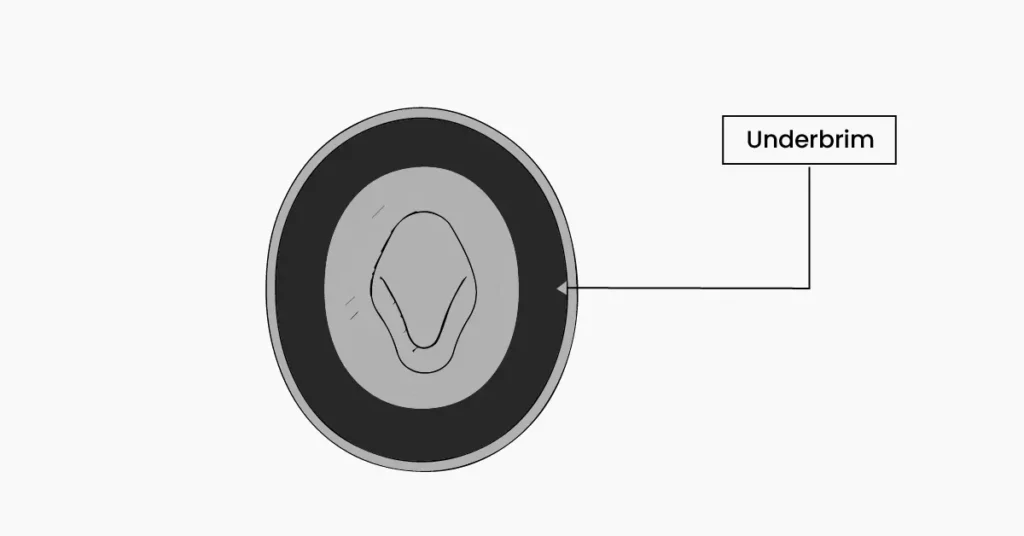
Hat Band
The hat band wraps around the base of the crown, just above the brim. It started as a simple way to cover the stitching between the crown and brim, but over time, it became a key part of the hat’s personality.
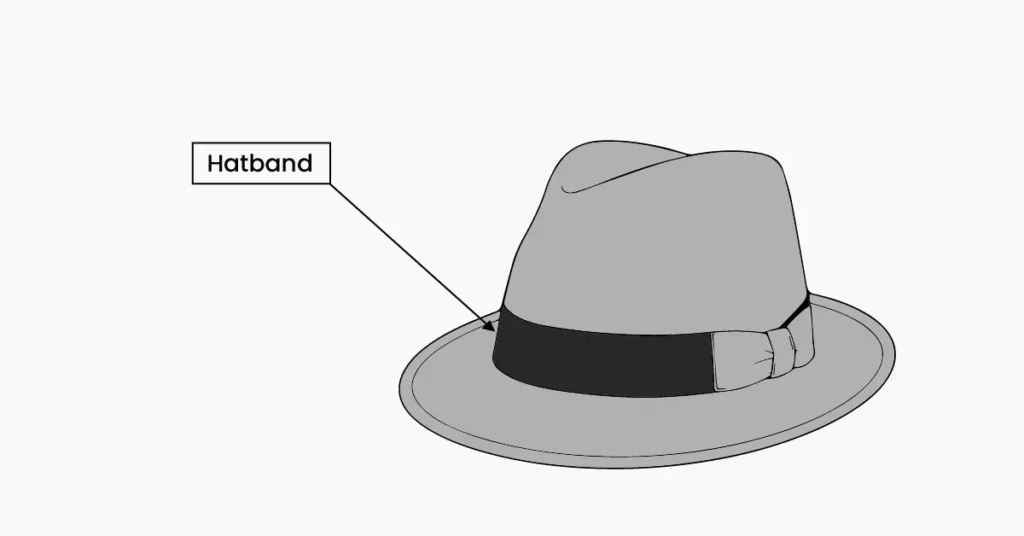
A ribbon band gives a smooth, classic finish and is common in felt and Panama hats. A leather band feels more rugged and natural. Some hat bands include small details like stitching, knots, or even a bow on one side—a tiny touch that balances the design and completes the look.
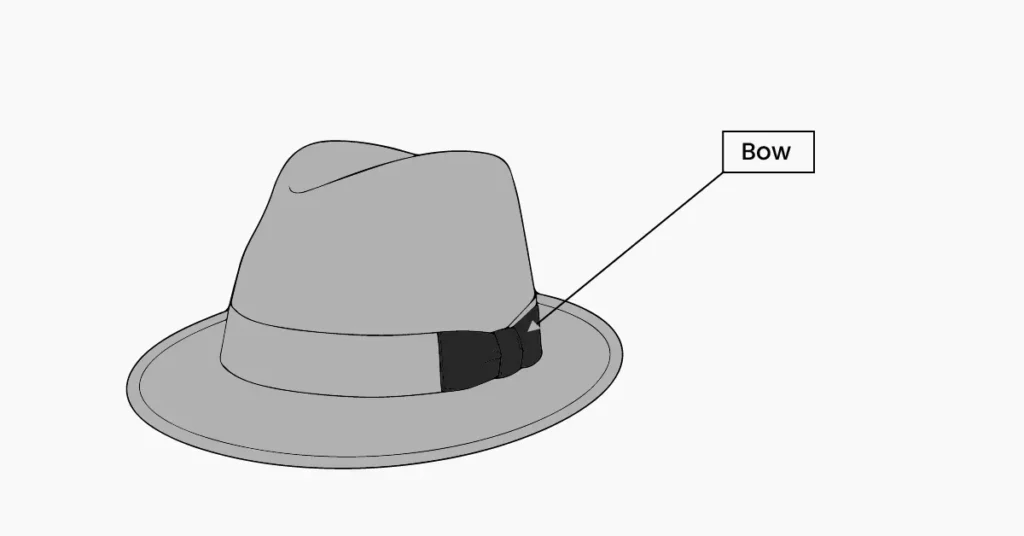
Some people even swap out hat bands to match an outfit or change the style. It’s a small detail, but it can make a big difference in how the hat feels and looks.
Sweatband
Inside the hat, you’ll find a soft band that runs around the inner base of the crown. This is the sweatband. It makes the hat more comfortable to wear and keeps sweat or oils from damaging the outer material.
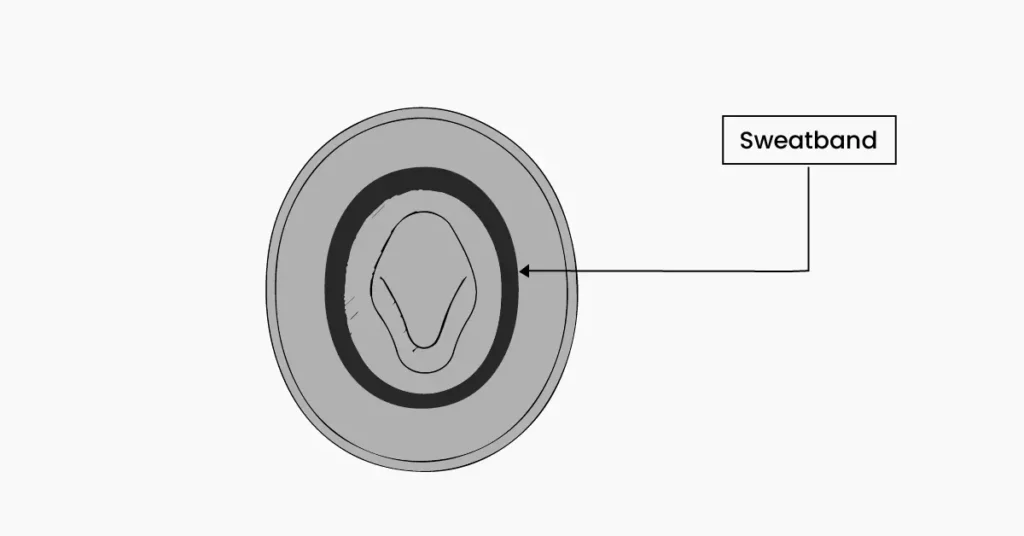
A well-made sweatband also helps the hat fit better. It should sit snugly but not tight, giving you support without pressure.
Lining
Some hats have a lining inside the crown. It’s usually made from stain, silk, or soft cotton. It protects the hat from sweat and wear, while also giving the inside a smooth feel.
Formal or dress hats often have satin or silk linings for a touch of luxury, while casual hats sometimes skip the lining to stay light and breathable. Choosing an unlined hat in warm weather makes it feel cooler and more comfortable.
Hat Decoration
Finally, a few small parts complete the hat. This includes small touches like stitching on the crown, pins, badges, feathers, bows, or a hat ribbon tucked behind the hat band.
These little details might seem minor, but they give a hat character and make it look finished instead of plain.
Now that you know the key elements of a hat, let’s look at the different crown shapes you might come across.
Types of Hat Crown Shapes

The crown is one of the most important parts of a hat, and its shape can completely change the hat’s style and how it fits your head. Understanding the different crown shapes also makes it easier to figure out which hat styles suit your face shape best.
Popular Crown Shapes
Let’s look at the most common hat crowns you’ll see.
Round Crown
The round crown curves gently over the top of the head. It has a soft, rounded top with no dents or folds, which makes it comfortable to wear.
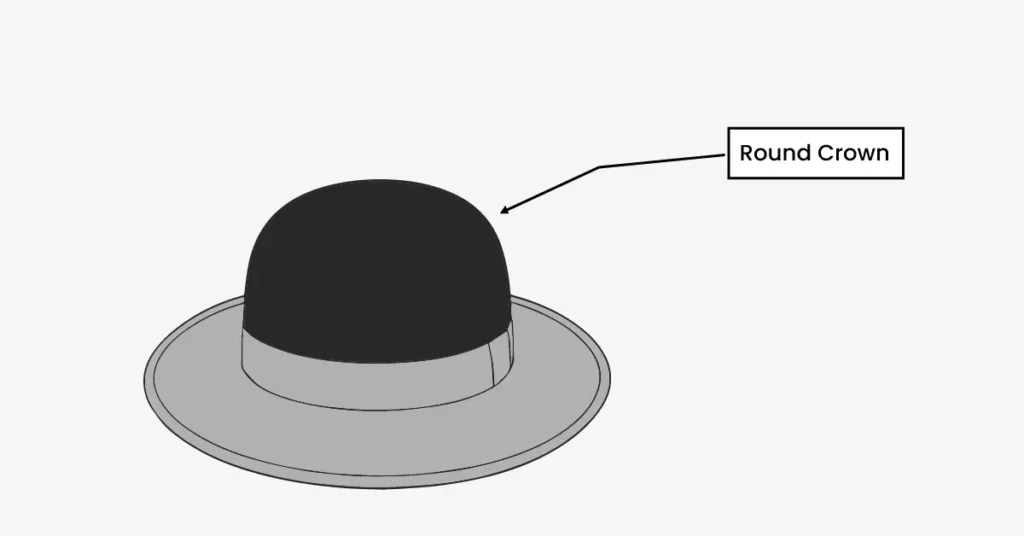
This shape is simple, easy to wear, and works well for casual hats. You’ll often see it in vintage or classic styles like bowler hats, cloche hats, or baseball caps. It gives the hat a clean, balanced look without being fussy.
Pinched Crown
The pinched crown has small indentations at the front or sides. It gives your fingers a natural place to hold the hat when putting it on or taking it off. It also adds a bit of character to the crown. You’ll often see this in fedoras and Panama hats.
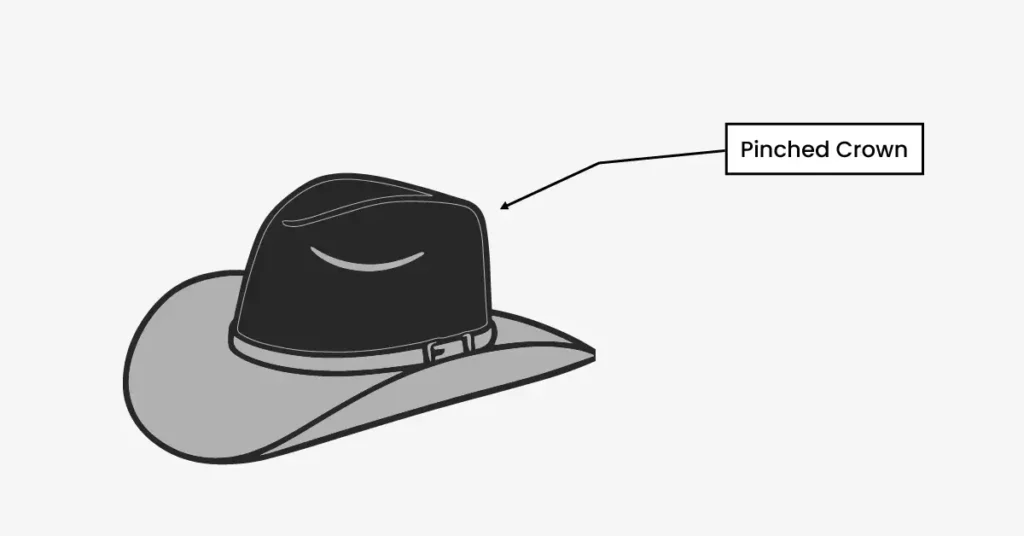
Teardrop Crown
The teardrop crown is narrow at the front and wider at the back, just like a teardrop when you look at it from above. It gives the hat a defined shape while keeping it comfortable and natural on your head. This crown is common in fedoras and other classic hats.
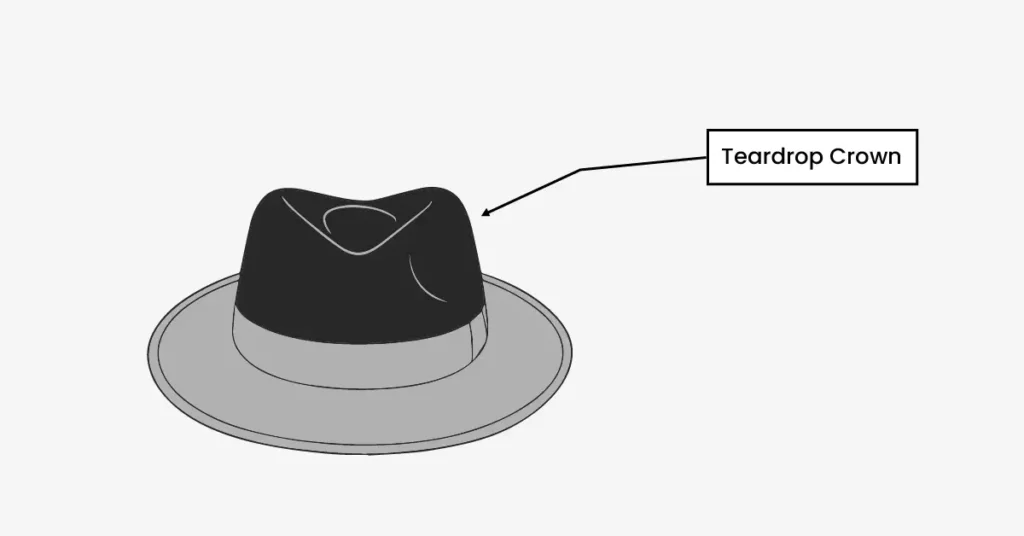
Center Dent Crown
The center dent crown runs down the middle of the crown. This crown is common in classic hats like fedoras and trilbies. It gives the hat structure and a timeless look that works well for both casual and formal styles.
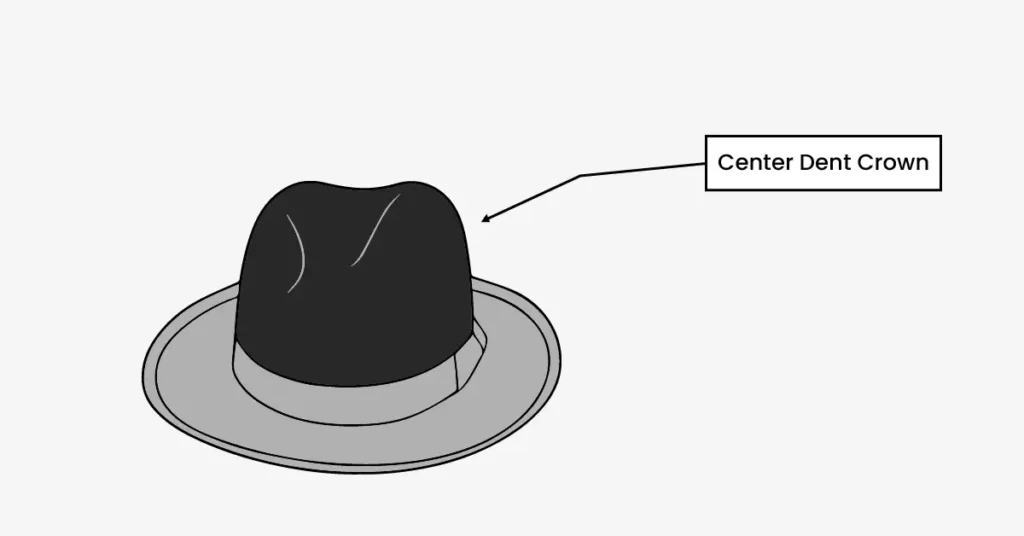
Cattleman Crown
The cattleman crown is common in cowboy hats. It has a center crease with side dents. This shape gives the hat a clear, recognizable style and keeps the crown structured.
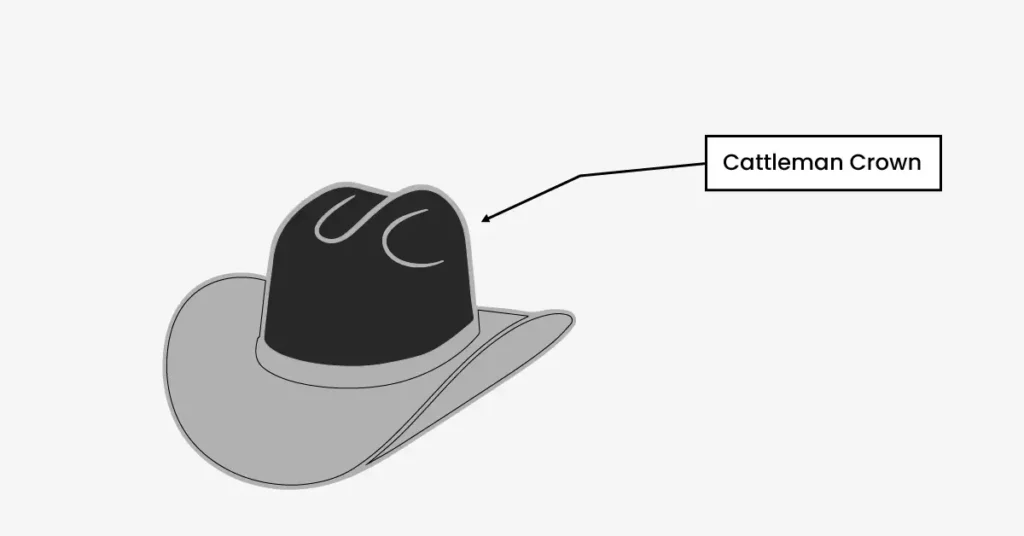
Less Common or Designer Shapes
Besides the popular shapes, there are a few less common crowns that give certain hats a unique or designer look.
Flat Crown
The flat crown is straight across the top. You see it in military-style hats and some modern caps. It looks precise and gives the hat a simple, neat appearance.

Diamond Crown
The diamond crown forms a subtle point at the top. It’s not common, but it gives some hats a unique look.
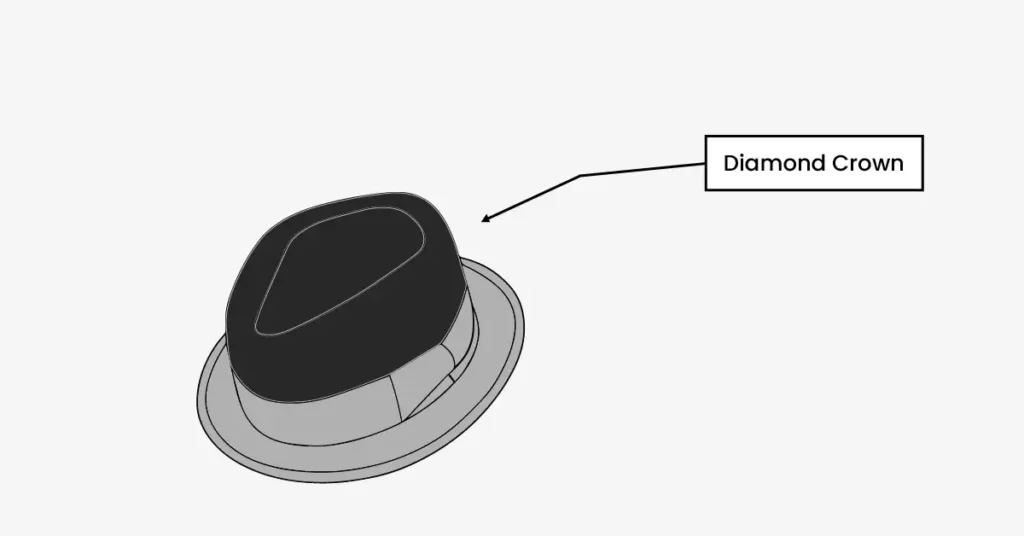
Open Crown
The open crown is unshaped or moldable. You can shape it yourself, making it practical for casual or adjustable hats.

Telescope Crown
The telescope crown has a flat top with a circular dip in the center, like a telescope lens. The edge around the top is slightly raised. You mostly see this crown in vintage or boutique hats. It stands out while still being easy to wear.
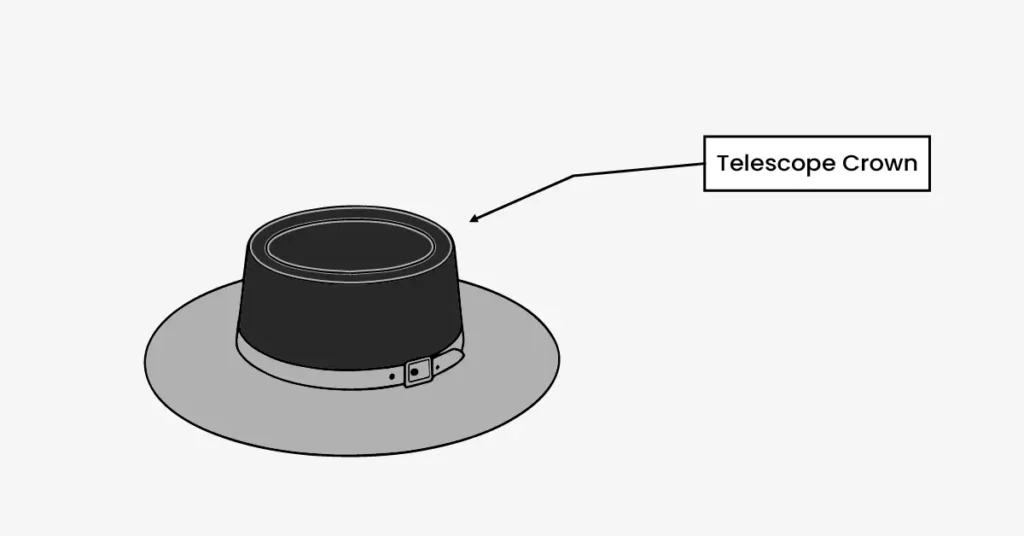
Gus, Optimo, and Bubble Crown
These are specialty crowns you might find in designer or vintage hats. Each has a different silhouette. They are less common, but they show the variety of hat styles that exist.
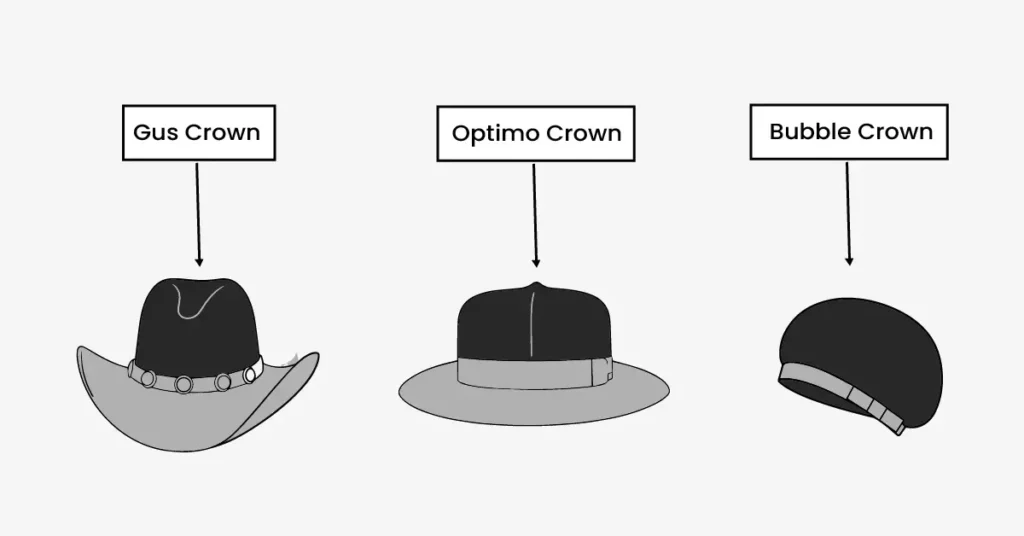
Now that you know the different crown shapes, let’s move on to the brim. It looks simple, but picking the wrong one can make even a great hat feel off.
Types of Hat Brims
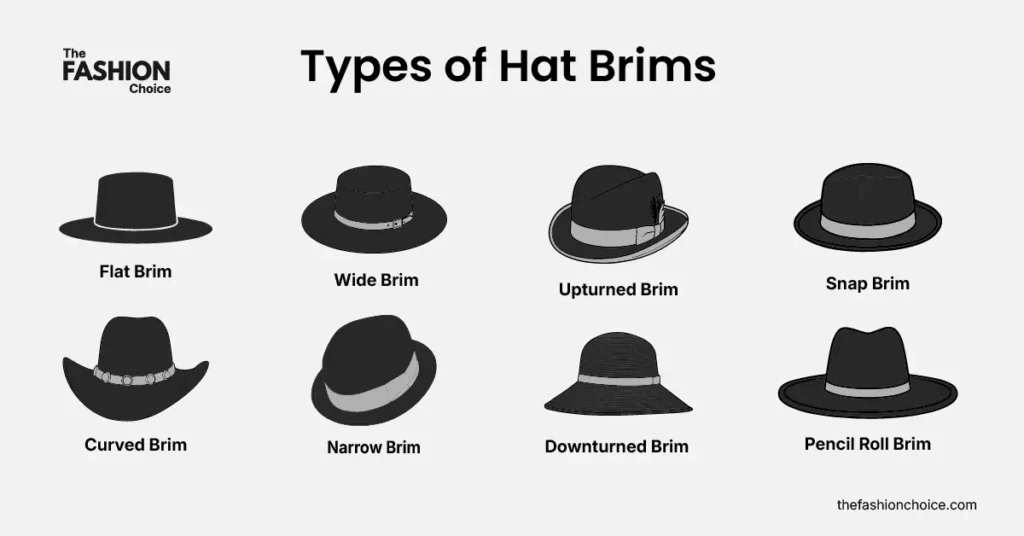
The brim is the part of the hat that goes around the crown and sticks out. It helps keep the sun, rain, or wind off your face and neck.
Brims come in different shapes—wide, narrow, flat, or curved. Each one changes how the hat looks and feels. Let’s take a closer look at the most common kinds of brims.
Flat Brim
A flat brim runs straight across from the crown. It gives the hat a clean, modern look. You mostly see it on snapbacks, fashion hats, or some modern fedoras. It’s a good choice if you want a hat that feels sharp and a little edgy.

Curved Brim
A curved brim bends down slightly, usually at the front. It helps block sunlight from your eyes, which is why it’s common on casual and outdoor hats. It’s simple, practical, and comfortable to wear.
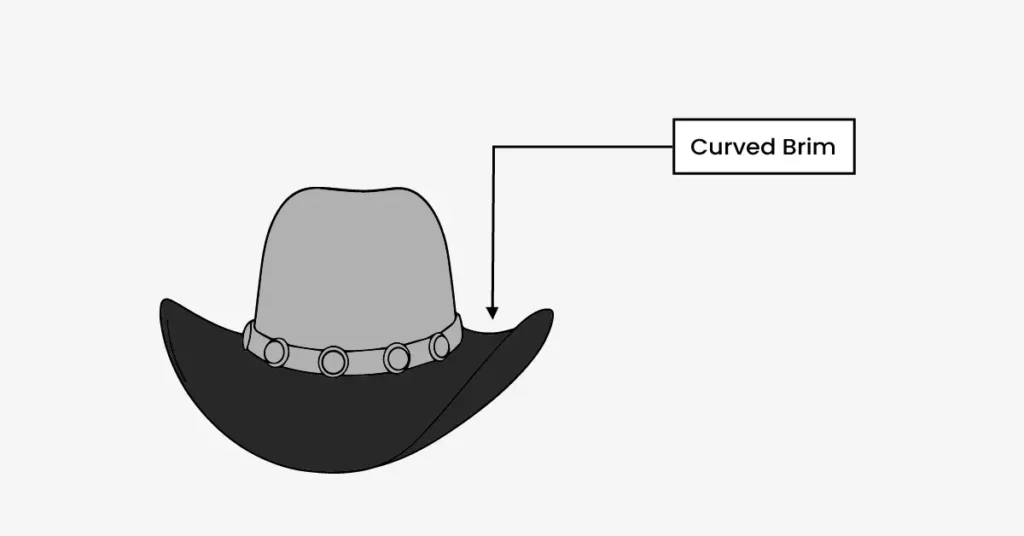
Wide Brim
A wide brim extends farther from the crown. Sun hats, cowboy hats, and some fedoras use wide brims. They give extra shade and make the hat look bold and noticeable.
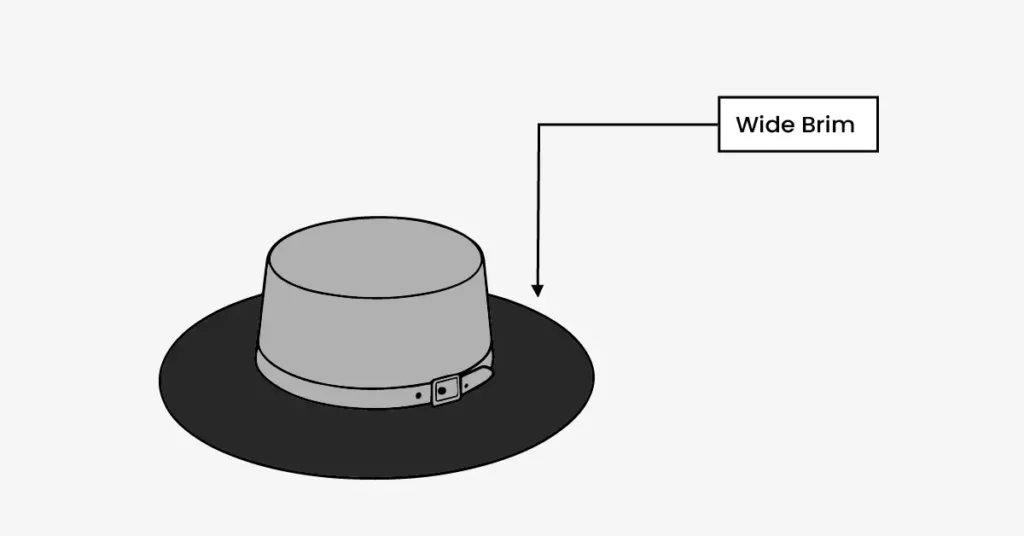
Narrow Brim
A narrow brim stays close to the crown. It doesn’t cover as much, but it keeps the hat neat and simple. You’ll see it on trilbies, fedoras, and other dressier hats. It makes the crown the main focus.
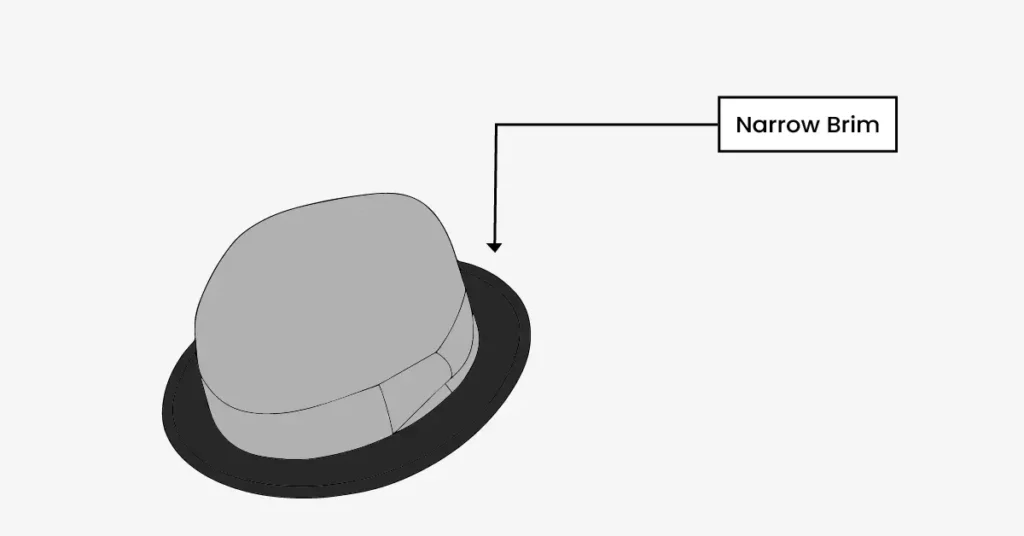
Upturned or Downturned Brim
Some brims bend slightly up or down. A downward tilt can make the hat look classic or elegant, while an upward tilt often feels more fun or formal. The angle can change the whole feel of the hat.
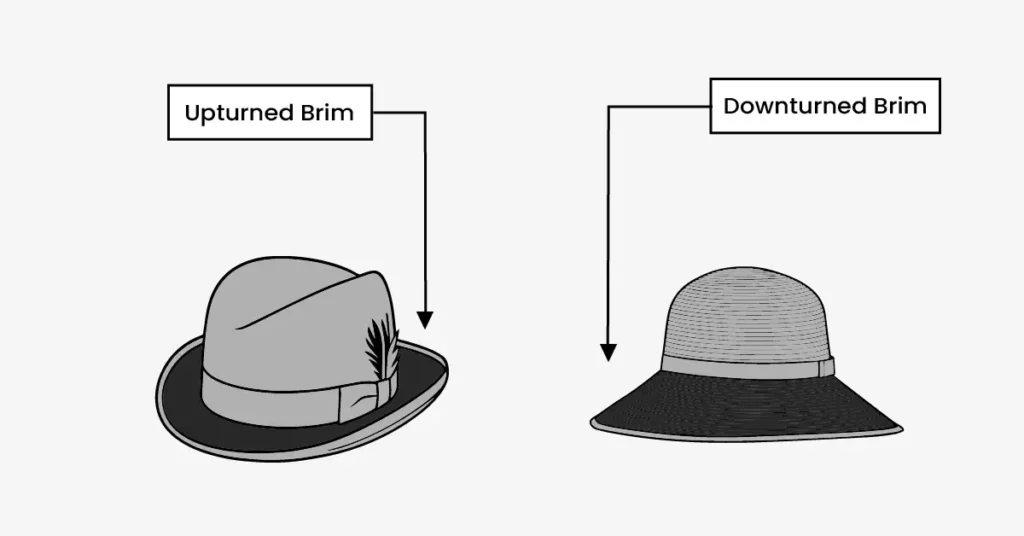
Snap Brim
A snap brim is usually flat, but you can bend the front up or down. How you wear it changes the hat’s look a little. It’s a small detail, but it can make a big difference in style.
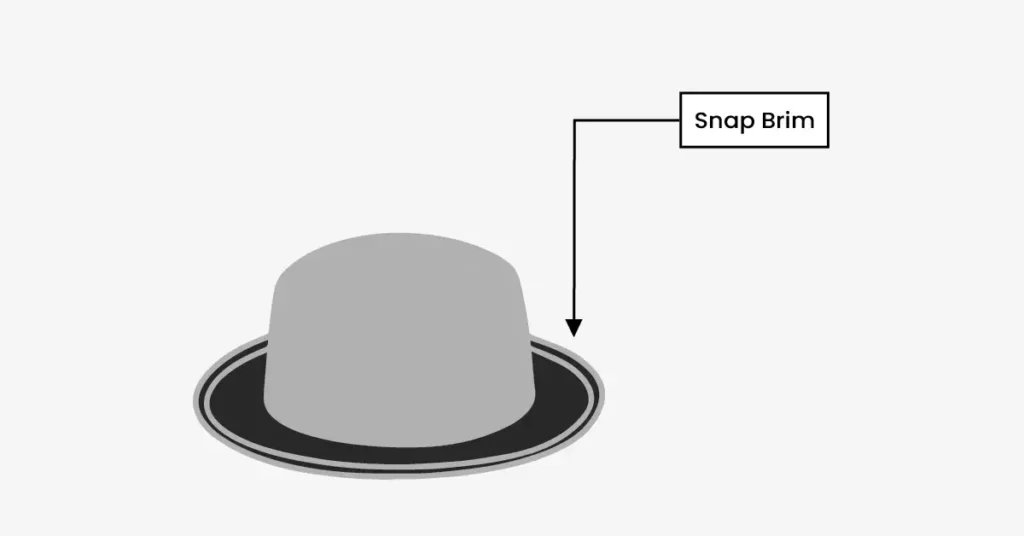
Pencil Roll Brim
The pencil roll brim has a thin edge rolled tightly around the brim. It’s a subtle detail that keeps the hat looking tidy and finished. You mostly see it on vintage or formal hats.
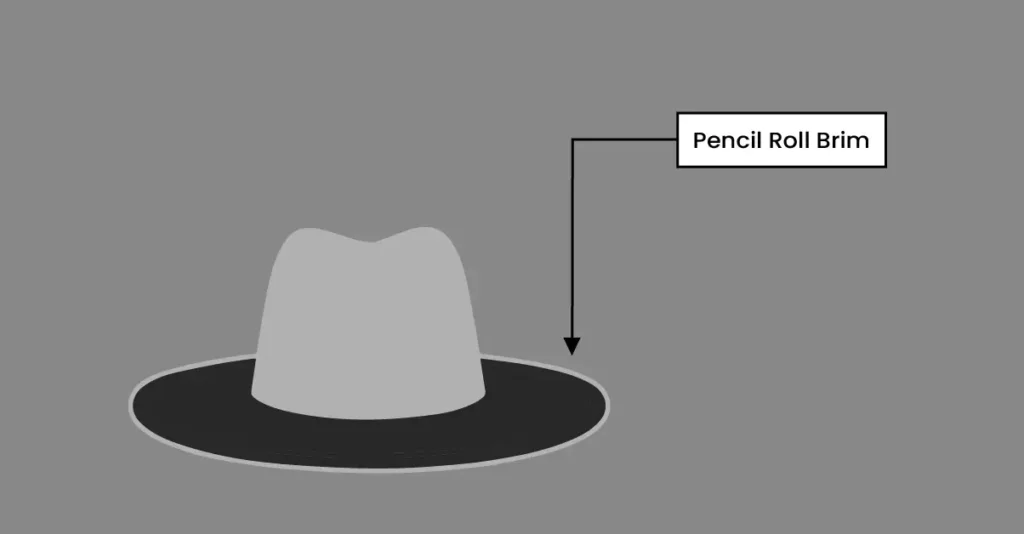
What’s the Difference Between a Brim and a Bill?
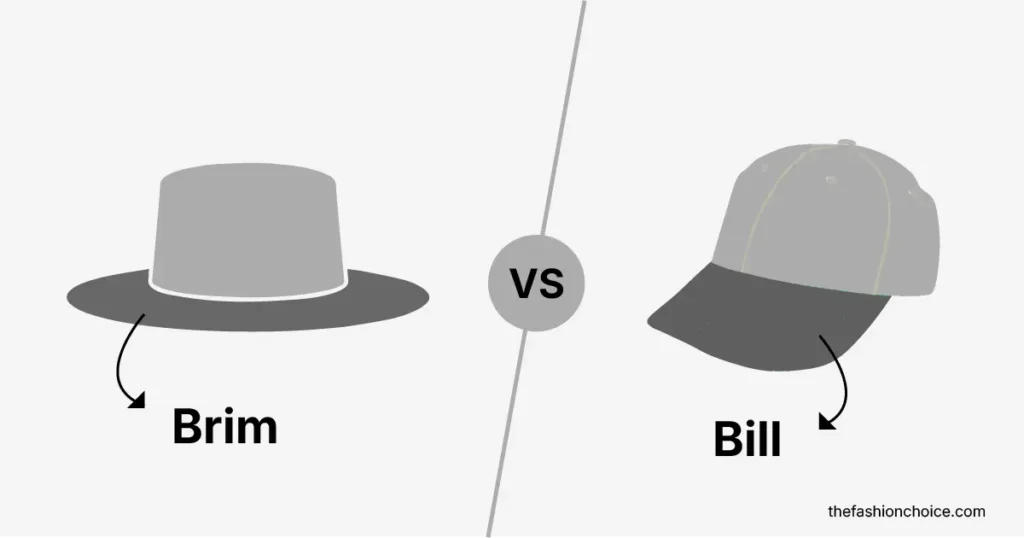
A lot of people use “brim” and “bill” interchangeably, but they’re different parts of a hat.
The brim is the part that goes all the way around the crown. It can be wide, narrow, flat, or curved, and its main job is to protect your face and neck from the sun. You’ll see brims on hats like fedoras, sun hats, and cowboy hats.
The bill, sometimes called a visor, sticks out only at the front. You find it on baseball caps and snapbacks. It usually curves to shade your eyes, rather than covering your whole head. You can see all the parts of a baseball cap in our detailed guide.
A simple way to remember it: If the edge goes all the way around, it’s a brim. If it’s just at the front, it’s a bill.
Types of Hat Materials
The material of a hat makes a big difference in how it feels, how it wears, and how long it lasts. Pick the wrong one and you might never wear the hat. Here are the main materials you’ll come across:
Cotton
Cotton is soft and breathable, which makes it comfortable for everyday wear, especially in warm weather. You’ll see it in baseball caps, bucket hats, and floppy sun hats. It’s light, easy to clear, and feels good against your skin.
Wool Felt
Wool felt is made by pressing wool fibers together. It keeps its shape well and is warm, so it’s good for cooler weather. Hats like fedoras, cloches, and pork pies often use wool felt. It gives the hat structure without feeling stiff.
Straw
Straw is light and lets your head breathe. It’s perfect for hot days and summer hats like Panama hats or wide-brimmed sun hats. Some straw is natural, some is synthetic. It looks similar, but natural straw usually lasts longer.
Leather
Leather is tough and lasts a long time. You’ll see it in cowboy hats and biker hats. It’s heavier than cotton or straw, but it molds to your head over time and looks better the more you wear it.
Polyester or Nylon
These are man-made, light, and usually resist water. They’re used in sporty or outdoor hats because they dry quickly and handle sweat well. They’re practical and easy to care for.
Toyo
Toyo is a woven paper that looks like straw. It’s coated to make it stronger and is common in stylish summer hats. It won’t last as long as straw or felt and doesn’t do well in wet weather, but it’s lightweight and looks good in the sun.
Fur Felt
Fur felt comes from animal fur, like rabbit or beaver. It’s soft, strong, and feels luxurious. You’ll mostly see it in high-end fedoras and vintage hats. It keeps its shape beautifully and lasts a long time if you take care of it.
Synthetics and Blends
Some hats use blends of polyester, nylon, or rayon. They’re durable, easy to clean, and don’t get damaged easily. They don’t breathe as well as natural materials, so they’re better for short-term wear or fashion hats.
Types of Hat Bands
The hat band sits around the base of the crown, right above the brim. At first, it was just to cover the stitching, but over the years it became one of the parts that gives a hat its personality.
Leather Bands
Leather bands are tough and simple. You’ll see them on cowboy hats and in more casual styles. They add a bit of texture and character, and over time, they wear in nicely, giving the hat some personality.
Fabric Bands
Fabric bands, like ribbon or cotton, are smooth and classic. They’re common on fedoras, Panama hats, and dress hats. You can pick plain ones or patterned ones, depending on how much style you want to add.
Horsehair Bands
Horsehair bands are stiff but lightweight. They’re used in some dress hats and military-style hats. They hold their shape and give the hat a clean, structured look.
Decorative Bands
Some hats have beads, braids, feathers, or even small stones on the band. These details make a hat stand out and give it a little personality without overdoing it.
Puggaree Bands
Puggarees are layered fabric bands, usually soft, wrapped around the crown. They’re common on military-style hats or vintage hats. They add texture and a subtle touch of style.
Concho-Embellished Bands
Conchos are small metal pieces you often see on cowboy hats. A concho band gives the hat a Western vibe and makes it instantly recognizable.
Custom Printed Fabric Bands
Some hats come with bands that are printed with patterns, designs, or logos. They’re easy to make a hat feel personal or match your outfit.
Many people ask, “Can I change or swap a hat band for a different look?“
Yes, you can. You can switch a leather band for a ribbon, add a braid, or tuck in a feather. It changes the look of the hat and makes it feel more personal without needing to buy a new one.
The band might seem like a small part of the hat, but it really changes the look. Pick the right one, and the hat will feel complete.
Hat Care and Maintenance
You’ve seen how every hat component matters, from the crown to the brim and the material it’s made of. But even the best hat can lose its shape if it’s not cared for. Over the years, we’ve picked up a few simple habits that keep hats looking good and feelings right every time you put them on.
Cleaning Your Hat
Cotton hats are easy—just spot clean or hand wash when needed. Wool felt and fur felt do better with a soft brush to get rid of dust.
Straw hats are delicate, so never soak them; a damp cloth to wipe off dirt works best. Leather hats need a little wipe and occasional conditioning so they don’t dry out or crack.
Storing Hats Properly
Don’t just pile hats on a shelf. Store them on a stand, in a box, or upside down on the crown. That keeps the shape intact. Straw and soft hats do best in a cool, dry spot to avoid bending or mildew.
Handling Hats
Grab the brim, not the crown, when you put it on or take it off. This keeps the crown from stretching or getting misshapen. If your hat has a pinch, use that naturally—it’s designed for handling without messing up the shape.
Protecting from the Weather
Rain can damage felt, straw, and wool hats, and leather can get spots. If your hat gets wet, shake off the water, reshape it gently, and let it air dry. The sun can fade colors over time, so rotate your hats and give them breaks from direct sunlight.
A little care goes a long way. Treat your hats right, and they’ll stay sharp, comfortable, and ready to wear for years.
Hat Styling Tips
Knowing what hat to wear and how to wear it makes a big difference. Over the years, we’ve seen people pick great hats but wear them wrong, or choose the wrong style for their face and end up feeling awkward. A few simple tips can fix that.
Start with your face: Taller crowns and medium brims work well on round faces. Longer faces balance better with wider brims. Square or heart-shaped faces soften with rounder crowns or slightly smaller brims. If you’re unsure which styles suit your face, you can try our free face shape tool to figure out what works best.
Think about the occasion. Don’t wear a sun hat to a formal event, and don’t reach for a fedora on a casual hike. Baseball caps, bucket hats, and casual fedoras are for everyday wear. Dressier hats suit more formal settings, and wide-brimmed or cowboy hats work best outdoors.
Fit matters. Grab the brim, not the crown, when you put it on. Make sure it feels comfortable—too tight and you won’t wear it, too loose and it looks off. If you don’t know your hat size, use our free hat size tool to find it quickly.
Consider material and season: light hats for summer, structured hats for cooler months. Finally, let the hat complement your outfit rather than clash with it. Neutral colors go with almost anything, and small details like the hat band can tie your look together.
Wear it right, and a hat can instantly lift your whole outfit.
Final Thoughts
Most people choose a hat just because it looks good. But later, they might find it doesn’t fit well or isn’t comfortable as they hoped.
When you understand the basic parts of a hat, like the crown, brim, and material, helps you pick one that actually works for you. Even a little knowledge can save you from buying the wrong hat.
